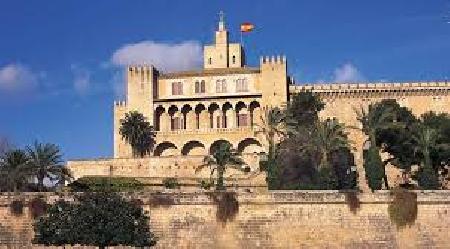 The Almudaina Palace in Palma de Mallorca is located on the site of an important ancient Roman settlement just opposite the main cathedral of the city. Its name means "citadel outside the city walls". The history of the Almudaina Palace is interesting. The Muslims built the building for defensive purposes and during his reign people with titles lived within its walls. The palace itself and its shape show the traces of an Arab fortress from the 12th and 13th centuries.
The Almudaina Palace in Palma de Mallorca is located on the site of an important ancient Roman settlement just opposite the main cathedral of the city. Its name means "citadel outside the city walls". The history of the Almudaina Palace is interesting. The Muslims built the building for defensive purposes and during his reign people with titles lived within its walls. The palace itself and its shape show the traces of an Arab fortress from the 12th and 13th centuries.
The Almudaina Palace in its current form was built at the beginning of the 14th century by order of King Jaime II and for a long time was considered the main residence of the Majorcan knights. During the reign of King Felipe II, it housed the residences of the viceroy and the commander in chief. Today La Almudaina remains the official residence of the Spanish King during his visits to Mallorca. Inside are a large number of works of art - Flemish tapestries from the 16th and 17th centuries depicting scenes from the history of Spain, Spanish tapestries from the 17th and 18th centuries, paintings depicting the Battle of Lepanto in 1571, and so on.
Among the most notable architectural elements of the Almudaina are the Gothic Royal Chapel of Santa Ana, built in the early fourteenth century, the Great Hall (aka Tinell), divided into two levels from the sixteenth century to accommodate more people, and the apartments of the Kings of the Palau del Rey in a rectangular tower. There are also Arab baths, another chapel, the Santa Praxeda, and the Throne Room with its huge arches. The palace is decorated in different styles: the ground floor is decorated in medieval style with various items from the XV-20 centuries, and the upper floors are used by the Spanish Royal Family for official events.
Not far from the palace is the Mallorca Museum and the Casa la Grande Cristiana, restored in the 19th century and now home to various archaeological artifacts, antiques and paintings by local artists.
Today, when the King of Spain comes to Mallorca, he stays at the Almudaina Palace. The building is the official residence of the royal family. In addition, the palace houses the National Museum and the military part of the island.
The palace is distinguished by its powerful facade, in whose corners watchtowers are built. One of the buildings (four towers in total) is called the Torre del Ángel. It was built in the XIV century. It can be identified by the statue of the Archangel Gabriel on top. He is also the patron saint of the city.
The second tower has a less pleasant name: the Torre de las Cabezas. It was thus nicknamed for some bloody events in the history of the fifteenth century. In ancient times the heads of executed people were exhibited here.
But let's not talk about sadness. Let's pay attention to the picturesque courtyard (Corte Real / Corte de Honor). Here is the Santa Ana chapel. The building dates from the 14th century and was built in the Romanesque style. The heroes of various mythical stories are represented at the entrance.
When you visit the Almudaina Palace, you should definitely see the Throne Room. Here the teachers have exceeded all expectations and have started to work on the technique of the Gothic style. In the room there are several objects, which belonged to the rulers of different periods.
The Royal Gardens below the palace are a picturesque place, where you can sit by the fountain and look at the world around you. In the surroundings you can visit the Arch of the Drassana. The gardens were recreated in the 1960s, with many houses having to be demolished.
Visiting hours and ticket prices
The palace is open from Monday to Friday from 10:00 to 17:45 (from October to March from 13:00 to 16:00). Saturdays and holidays from 10:00 to 13:15.
Ticket prices: normal entry costs 4 euros, preferential entry 2.30 euros, entry is free for children.
Address: Carrer del Palau Reial, s / n, 07001 Palma, Balearic Islands, Spain
Telephone: +34 902 04 44 54
